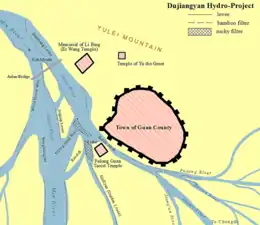Li Bing
Li Bing (Chinese: 李冰; pinyin: Lǐ Bīng; c. 3rd century BC) was a Chinese hydraulic engineer and politician of the Warring States period. He served the state of Qin as an administrator and is said to have been involved in the Dujiangyan Irrigation System project.

Life and career


King Zhaoxiang of Qin (r. 306–251 BC) dispatched Li Bing as joint military and civilian governor (shou) over Shu, a recently defeated state in Sichuan province, Southwest China, just west of modern Chengdu. According to the Records of the Grand Historian, Li Bing was appointed governor of Shu in c. 277 BC.[1][2] However, the Chronicles of Huayang place Li Bing in Shu in 272 BC.[3][4] He arrived just as Zhang Ruo had put down the last of the marquis rebellions and moved out to engage the Chu city of Yan. Zhang Ruo did not leave any incumbent ministers, and Li Bing had complete control over Shu. (Sage, 149) "When he arrived in Shu, Li Bing witnessed the sufferings of local people from frequent flooding of the Min River." Additionally, the Qin monarchy had been sending its exiles to this state and the Qin military needed food and infrastructure.
Li Bing then created “the largest, most carefully planned public works project yet seen anywhere on the eastern half of the Eurasian continent.” It would be called Dujiangyan. (Sage, 149) He conducted an extensive hydraulic survey of the Min River in order to stabilize the waters from flooding settlements and plot out an extension into Chengdu. This extension would be a fairway to provide logistical military support to the Chengdu supply lines. This is standard practice for Qin administrators who routinely combine their agricultural projects for both civilian and military purposes. (Ibid) The Min River is 735 km long and it is the largest and the longest of the Yangtze tributaries.
Li Bing faced a number of daunting tasks. Firstly, the Qin administration was more experienced working with arid lands than with wet rice paddies. Additionally, by slowing the water current, this reduced the river’s ability to carry away large amounts of sediment. At peak discharge, the Min flows at about 5000 or even 6000 cubic meters per second. At low water, it lessens to about 500 cubic meters per second. (Elvin, 121 edited) On the other hand, the water diversion would have a positive effect and with the Qin system of land distribution with wet paddy rice in the Chengdu plains.
But that was only half of the problem. The other half had to do with Shu culture. The native Animist people of Shu believed that the Min was a deity. As recorded in the Shiji, “Sima Qian relates the tale that, upon appointment as administrator of Po, a province of Wei, Ximen Bao discouraged the superstition of the people about a bride for the god of the river and punished the local gentry and bureaucrats who took advantage of such superstitions.” (Chi, 67) This was the ordinary practice of Administrators across the region. But, Ximen Bao did not succeed. Therefore, in order to avert a similar massive revolt, Li Bing set out to end this practice “by a combination of tact and showmanship”. (Sage, 150)
Steven Sage describes from the Shiji that the first thing Li Bing did was set up a temple to honor the Min deity. He then offered his own two daughters as brides to the deity. But first he set up a large nuptial banquet along the river. He offered a toast. But the deity did not drink his glass of wine. Deeply offended, Li Bing runs off sword drawn. Two bulls prepared in advance were then seen by the crowd fighting along the river bank. Symbolically, this was Li Bing in a duel with the deity. Li Bing returns to the scene sweating as if in battle and calls for assistance. One of his lieutenants ran up to the bull that Li Bing had pointed out was the deity and killed the bull. The river spirit was subdued. (Sage 150-151, Shiji, ch.116, xi nan yi lie zhuan, pp 2995–2996.)
The workers were mostly exiles from lands conquered by the Qin and the local population.
References
- Sage, Steven F., Ancient Sichuan and the Unification of China. Albany, New York: State University of New York Press (1992). 148.
- Records of the Grand Historian. cxvi (Xi nan yi lie zhuan), 2995
- Chang Jue's Huayang-guo zhi. Shanghai: Shanghai Ancient Books Publishing House. 132 - 141
- Taming the floodwaters: The high heritage price of massive hydraulic projects. China Heritage Newsletter. China Heritage Project, The Australian National University. No. 1, 2005.03.
External links
- Chi, Ch‘ao-ting. Key Economic Areas in Chinese History as Revealed in the Development of Public Works for Water-Control. Ed. Relations, American Institute of Pacific. 2d ed. New York, Paragon Book Reprint Corp., 1963.
- Cotterell, Arthur. First Emperor of China. London: MacMillan London Limited, 1981.
- Elvin, Mark. The Retreat of the Elephants: An Environmental History of China 1st ed. New Haven, Conn.; London: Yale University Press, 2004.
- Sage, Steven F., Ancient Sichuan and the Unification of China, Albany, New York: State University of New York Press (1992). ISBN 0-7914-1038-2
- CHN “Taming the Floodwaters: The High Heritage Price of Massive Hydraulic Projects” China Heritage Newsletter China Heritage Project, Research School of Pacific and Asian Studies (RSPAS), The Australian National University No. 1, March 2005. ISSN 1833-8461.
- 8 April 2005. 27 June 2006.
- PRC “Li Bing” chinaculture.org 2003. 27 June 2006.
